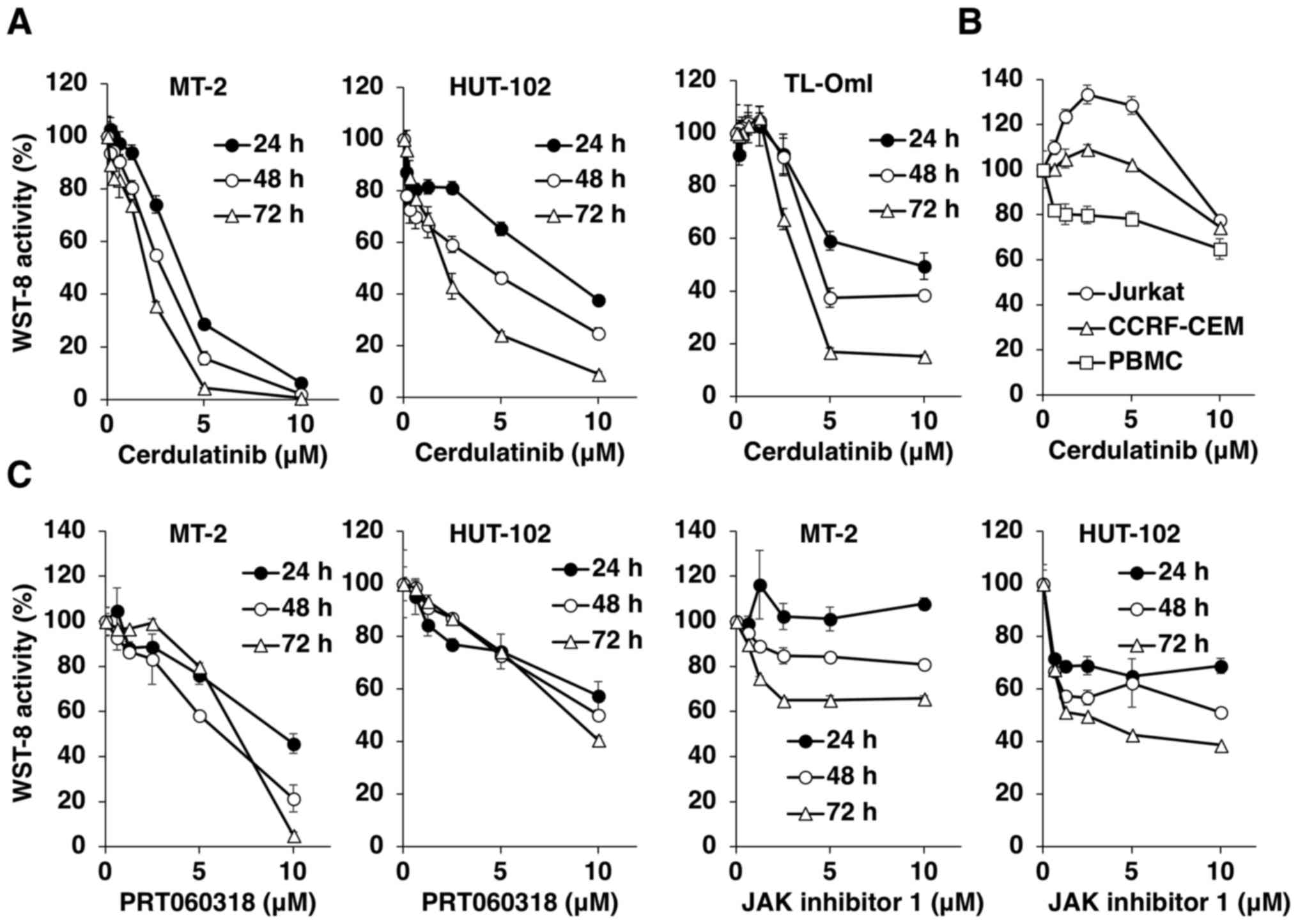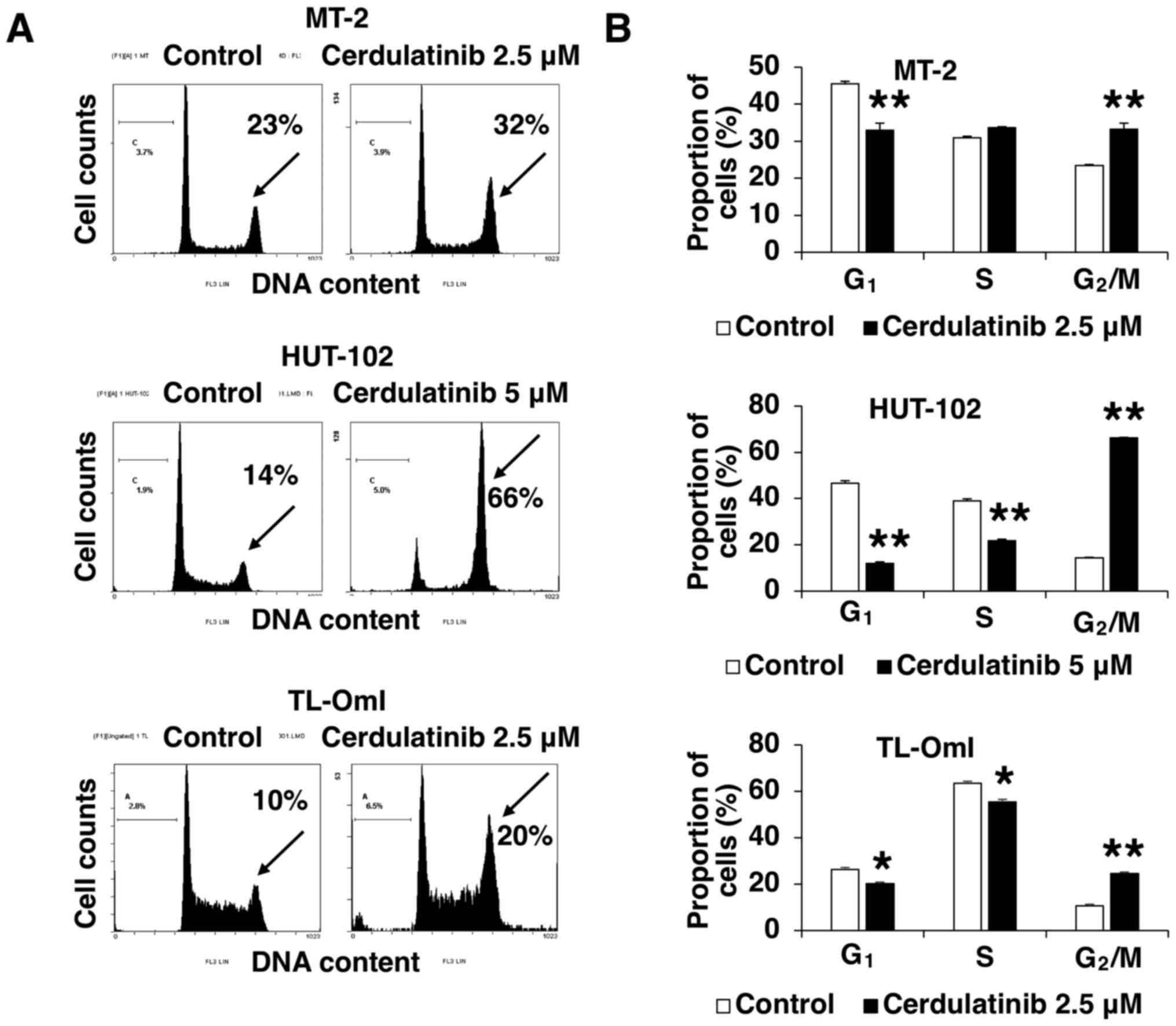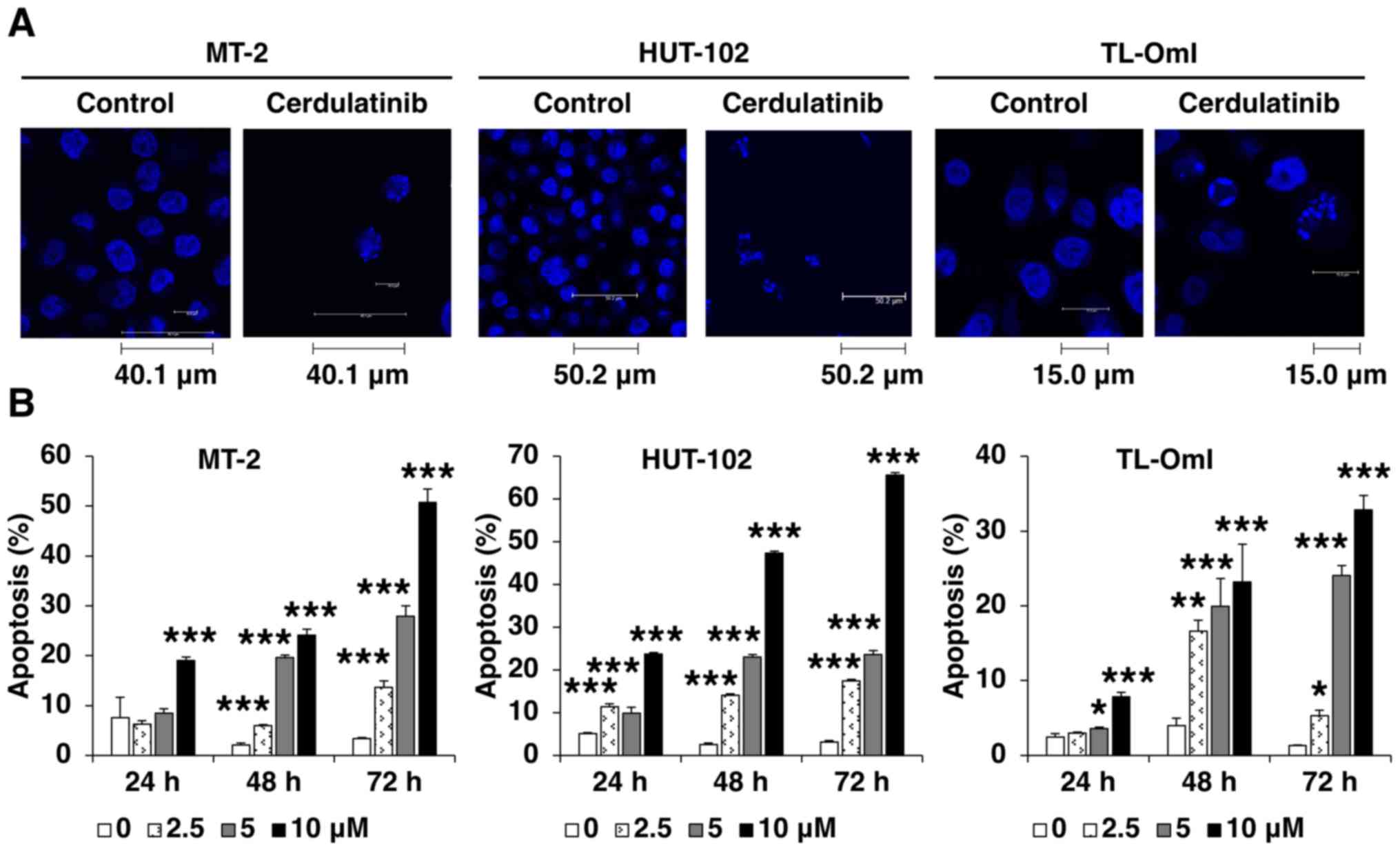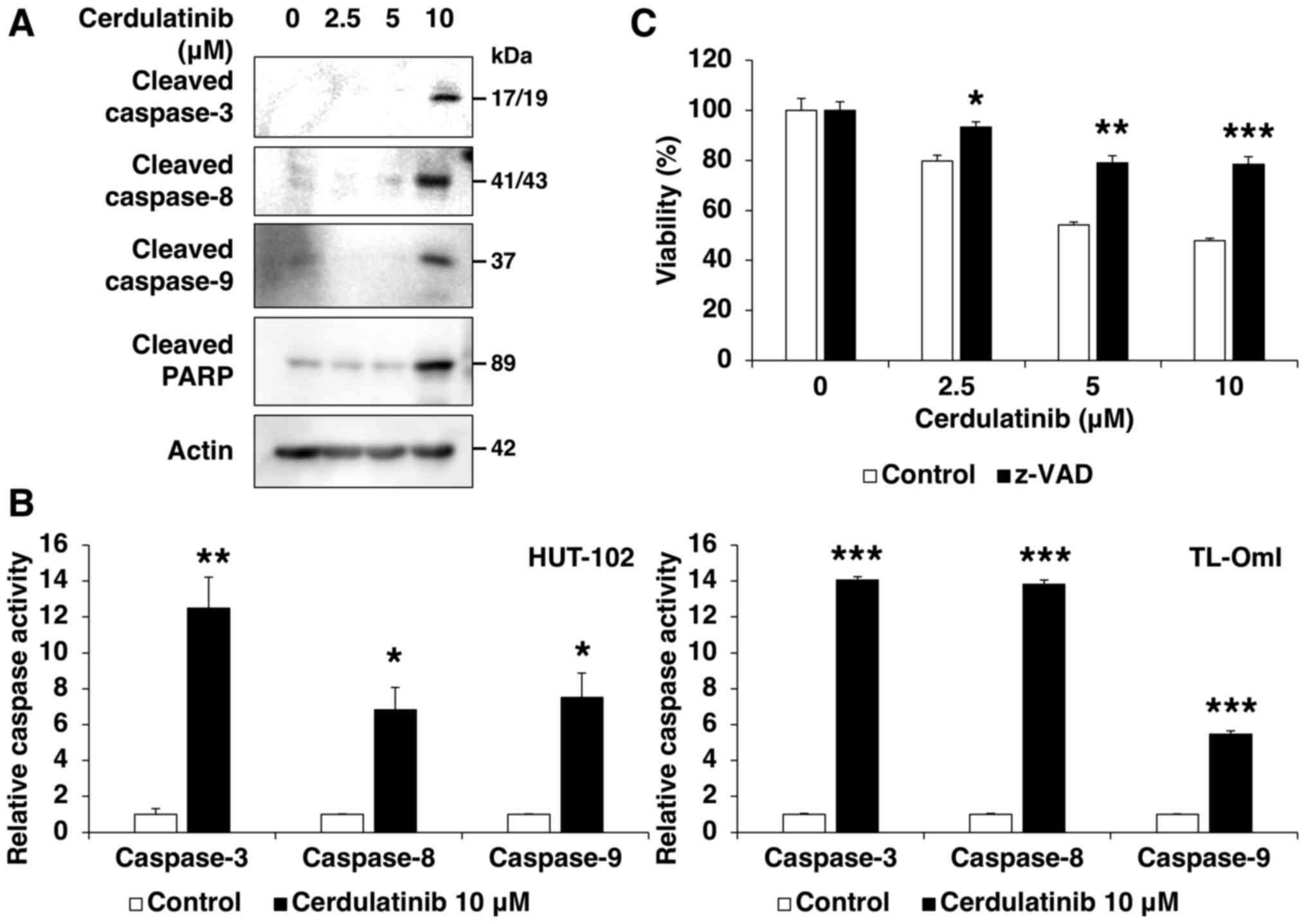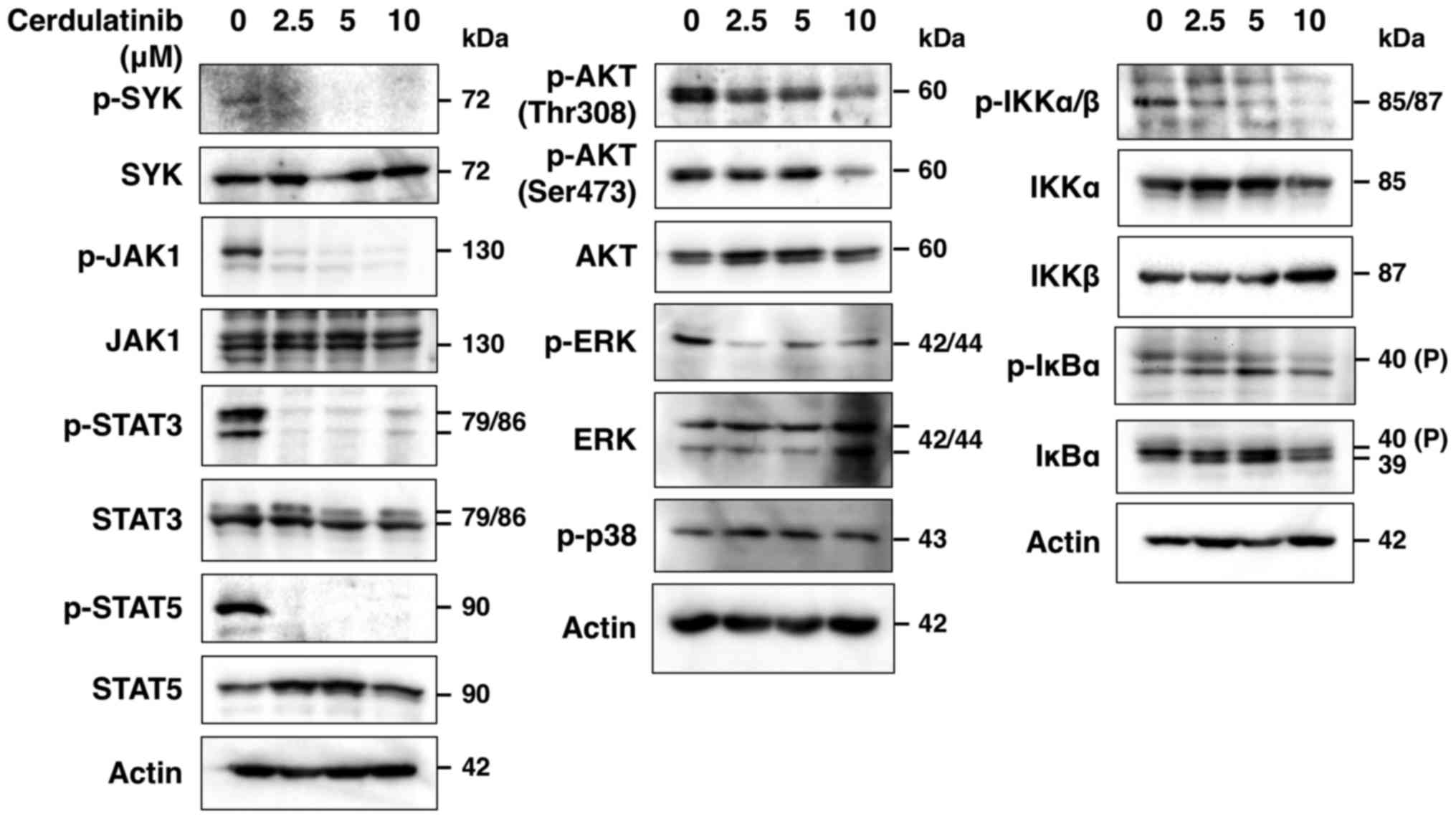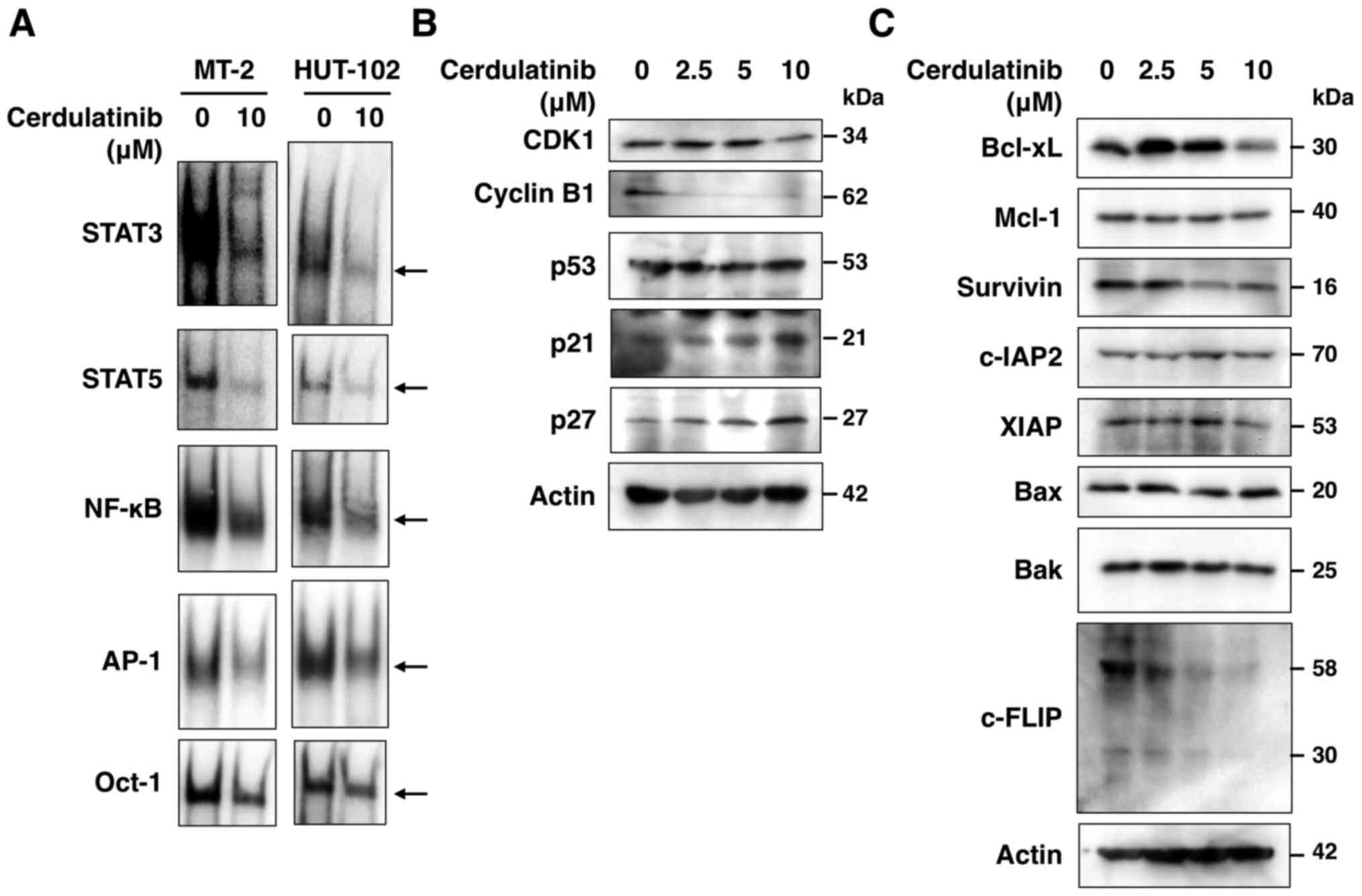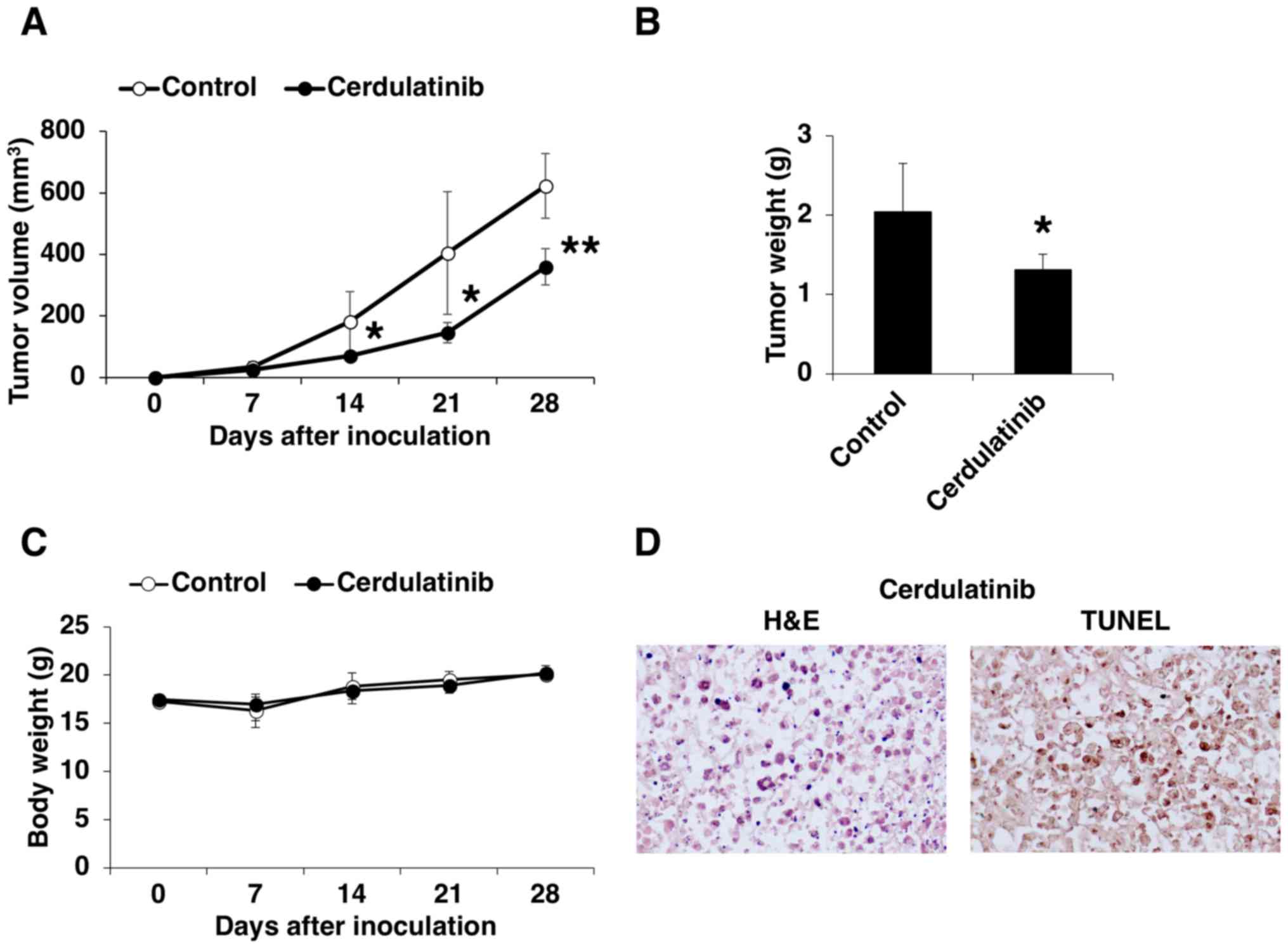|
1
|
Iwanaga M, Watanabe T and Yamaguchi K:
Adult T-cell leukemia: A review of epidemiological evidence. Front
Microbiol. 3:3222012. View Article : Google Scholar : PubMed/NCBI
|
|
2
|
Katsuya H and Ishitsuka K: Treatment
advances and prognosis for patients with adult T-cell
leukemia-lymphoma. J Clin Exp Hematop. 57:87–97. 2017. View Article : Google Scholar : PubMed/NCBI
|
|
3
|
Yssel H, de Waal Malefyt R, Duc Dodon MD,
Blanchard D, Gazzolo L, de Vries JE and Spits H: Human T cell
leukemia/lymphoma virus type I infection of a CD4+
proliferative/cytotoxic T cell clone progresses in at least two
distinct phases based on changes in function and phenotype of the
infected cells. J Immunol. 142:2279–2289. 1989.PubMed/NCBI
|
|
4
|
Miyazaki T and Taniguchi T: Coupling of
the IL2 receptor complex with non-receptor protein tyrosine
kinases. Cancer Surv. 27:25–40. 1996.PubMed/NCBI
|
|
5
|
Rochman Y, Spolski R and Leonard WJ: New
insights into the regulation of T cells by gamma(c) family
cytokines. Nat Rev Immunol. 9:480–490. 2009. View Article : Google Scholar : PubMed/NCBI
|
|
6
|
Migone TS, Lin JX, Cereseto A, Mulloy JC,
O'Shea JJ, Franchini G and Leonard WJ: Constitutively activated
Jak-STAT pathway in T cells transformed with HTLV-I. Science.
269:79–81. 1995. View Article : Google Scholar : PubMed/NCBI
|
|
7
|
Xu X, Kang SH, Heidenreich O, Okerholm M,
O'Shea JJ and Nerenberg MI: Constitutive activation of different
Jak tyrosine kinases in human T cell leukemia virus type 1 (HTLV-1)
tax protein or virus-transformed cells. J Clin Invest.
96:1548–1555. 1995. View Article : Google Scholar : PubMed/NCBI
|
|
8
|
Takemoto S, Mulloy JC, Cereseto A, Migone
T-S, Patel BKR, Matsuoka M, Yamaguchi K, Takatsuki K, Kamihira S,
White JD, et al: Proliferation of adult T cell leukemia/lymphoma
cells is associated with the constitutive activation of JAK/STAT
proteins. Proc Natl Acad Sci USA. 94:13897–13902. 1997. View Article : Google Scholar
|
|
9
|
Ju W, Zhang M, Jiang J-K, Thomas CJ, Oh U,
Bryant BR, Chen J, Sato N, Tagaya Y, Morris JC, et al: CP-690,550,
a therapeutic agent, inhibits cytokine-mediated Jak3 activation and
proliferation of T cells from patients with ATL and HAM/TSP. Blood.
117:1938–1946. 2011. View Article : Google Scholar :
|
|
10
|
Zhang M, Mathews Griner LA, Ju W, Duveau
DY, Guha R, Petrus MN, Wen B, Maeda M, Shinn P, Ferrer M, et al:
Selective targeting of JAK/STAT signaling is potentiated by Bcl-xL
blockade in IL-2-dependent adult T-cell leukemia. Proc Natl Acad
Sci USA. 112:12480–12485. 2015. View Article : Google Scholar : PubMed/NCBI
|
|
11
|
Weil R, Levraud J-P, Dodon MD, Bessia C,
Hazan U, Kourilsky P and Israël A: Altered expression of tyrosine
kinases of the Src and Syk families in human T-cell leukemia virus
type 1-infected T-cell lines. J Virol. 73:3709–3717.
1999.PubMed/NCBI
|
|
12
|
Coffey G, Betz A, DeGuzman F, Pak Y,
Inagaki M, Baker DC, Hollenbach SJ, Pandey A and Sinha U: The novel
kinase inhibitor PRT062070 (Cerdulatinib) demonstrates efficacy in
models of autoimmunity and B-cell cancer. J Pharmacol Exp Ther.
351:538–548. 2014. View Article : Google Scholar : PubMed/NCBI
|
|
13
|
Ma J, Xing W, Coffey G, Dresser K, Lu K,
Guo A, Raca G, Pandey A, Conley P, Yu H, et al: Cerdulatinib, a
novel dual SYK/JAK kinase inhibitor, has broad anti-tumor activity
in both ABC and GCB types of diffuse large B cell lymphoma.
Oncotarget. 6:43881–43896. 2015. View Article : Google Scholar : PubMed/NCBI
|
|
14
|
Blunt MD, Koehrer S, Dobson RC, Larrayoz
M, Wilmore S, Hayman A, Parnell J, Smith LD, Davies A, Johnson PWM,
et al: The dual Syk/JAK inhibitor cerdulatinib antagonizes B-cell
receptor and microenvironmental signaling in chronic lymphocytic
leukemia. Clin Cancer Res. 23:2313–2324. 2017. View Article : Google Scholar
|
|
15
|
Guo A, Lu P, Coffey G, Conley P, Pandey A
and Wang YL: Dual SYK/JAK inhibition overcomes ibrutinib resistance
in chronic lymphocytic leukemia: Cerdulatinib, but not ibrutinib,
induces apoptosis of tumor cells protected by the microenvironment.
Oncotarget. 8:12953–12967. 2017.PubMed/NCBI
|
|
16
|
Liu D and Mamorska-Dyga A: Syk inhibitors
in clinical development for hematological malignancies. J Hematol
Oncol. 10:1452017. View Article : Google Scholar : PubMed/NCBI
|
|
17
|
Stapper NJ, Stuschke M, Sak A and Stüben
G: Radiation-induced apoptosis in human sarcoma and glioma cell
lines. Int J Cancer. 62:58–62. 1995. View Article : Google Scholar : PubMed/NCBI
|
|
18
|
Mori N and Prager D: Transactivation of
the interleukin-1alpha promoter by human T-cell leukemia virus type
I and type II Tax proteins. Blood. 87:3410–3417. 1996.PubMed/NCBI
|
|
19
|
Ishikawa C, Senba M and Mori N: Butein
inhibits NF-κB, AP-1 and Akt activation in adult T-cell
leukemia/lymphoma. Int J Oncol. 51:633–643. 2017. View Article : Google Scholar : PubMed/NCBI
|
|
20
|
Tomayko MM and Reynolds CP: Determination
of subcutaneous tumor size in athymic (nude) mice. Cancer Chemother
Pharmacol. 24:148–154. 1989. View Article : Google Scholar : PubMed/NCBI
|
|
21
|
Mócsai A, Ruland J and Tybulewicz VL: The
SYK tyrosine kinase: A crucial player in diverse biological
functions. Nat Rev Immunol. 10:387–402. 2010. View Article : Google Scholar : PubMed/NCBI
|
|
22
|
Zheng Z, Li Z, Chen S, Pan J and Ma X:
Tetramethylpyrazine attenuates TNF-α-induced iNOS expression in
human endothelial cells: Involvement of Syk-mediated activation of
PI3K-IKK-IκB signaling pathways. Exp Cell Res. 319:2145–2151. 2013.
View Article : Google Scholar : PubMed/NCBI
|
|
23
|
Hatton O, Lambert SL, Krams SM and
Martinez OM: Src kinase and Syk activation initiate PI3K signaling
by a chimeric latent membrane protein 1 in Epstein-Barr virus
(EBV)+ B cell lymphomas. PLoS One. 7:e426102012. View Article : Google Scholar : PubMed/NCBI
|
|
24
|
Wang LH, Kirken RA, Erwin RA, Yu C-R and
Farrar WL: JAK3, STAT, and MAPK signaling pathways as novel
molecular targets for the tyrphostin AG-490 regulation of
IL-2-mediated T cell response. J Immunol. 162:3897–3904.
1999.PubMed/NCBI
|
|
25
|
Sherr CJ: Cancer cell cycles. Science.
274:1672–1677. 1996. View Article : Google Scholar : PubMed/NCBI
|
|
26
|
Karimian A, Ahmadi Y and Yousefi B:
Multiple functions of p21 in cell cycle, apoptosis and
transcriptional regulation after DNA damage. DNA Repair (Amst).
42:63–71. 2016. View Article : Google Scholar
|
|
27
|
Hu X and Moscinski LC: Cdc2: A monopotent
or pluripotent CDK? Cell Prolif. 44:205–211. 2011. View Article : Google Scholar : PubMed/NCBI
|
|
28
|
Guadagno TM and Newport JW: Cdk2 kinase is
required for entry into mitosis as a positive regulator of
Cdc2-cyclin B kinase activity. Cell. 84:73–82. 1996. View Article : Google Scholar : PubMed/NCBI
|
|
29
|
Yadav S, Kalra N, Ganju L and Singh M:
Activator protein-1 (AP-1): A bridge between life and death in lung
epithelial (A549) cells under hypoxia. Mol Cell Biochem.
436:99–110. 2017. View Article : Google Scholar : PubMed/NCBI
|
|
30
|
Zhang Y-X, Li X-F, Yuan G-Q, Hu H, Song
X-Y, Li J-Y, Miao X-K, Zhou T-X, Yang W-L, Zhang X-W, et al:
β-Arrestin 1 has an essential role in neurokinin-1
receptor-mediated glioblastoma cell proliferation and
G2/M phase transition. J Biol Chem. 292:8933–8947. 2017.
View Article : Google Scholar : PubMed/NCBI
|
|
31
|
Manning BD and Cantley LC: AKT/PKB
signaling: Navigating downstream. Cell. 129:1261–1274. 2007.
View Article : Google Scholar : PubMed/NCBI
|
|
32
|
Roy SK, Srivastava RK and Shankar S:
Inhibition of PI3K/AKT and MAPK/ERK pathways causes activation of
FOXO transcription factor, leading to cell cycle arrest and
apoptosis in pancreatic cancer. J Mol Signal. 5:102010. View Article : Google Scholar : PubMed/NCBI
|
|
33
|
Das D, Pintucci G and Stern A:
MAPK-dependent expression of p21(WAF) and p27(kip1) in PMA-induced
differentiation of HL60 cells. FEBS Lett. 472:50–52. 2000.
View Article : Google Scholar : PubMed/NCBI
|
|
34
|
Kim R, Tanabe K, Uchida Y, Emi M, Inoue H
and Toge T: Current status of the molecular mechanisms of
anticancer drug-induced apoptosis. The contribution of
molecular-level analysis to cancer chemotherapy. Cancer Chemother
Pharmacol. 50:343–352. 2002. View Article : Google Scholar : PubMed/NCBI
|
|
35
|
Krueger A, Baumann S, Krammer PH and
Kirchhoff S: FLICE-inhibitory proteins: Regulators of death
receptor-mediated apoptosis. Mol Cell Biol. 21:8247–8254. 2001.
View Article : Google Scholar : PubMed/NCBI
|
|
36
|
Catlett-Falcone R, Dalton WS and Jove R:
STAT proteins as novel targets for cancer therapy. Signal
transducer an activator of transcription. Curr Opin Oncol.
11:490–496. 1999. View Article : Google Scholar : PubMed/NCBI
|
|
37
|
Zheng HC: The molecular mechanisms of
chemoresistance in cancers. Oncotarget. 8:59950–59964.
2017.PubMed/NCBI
|
|
38
|
Allan LA, Morrice N, Brady S, Magee G,
Pathak S and Clarke PR: Inhibition of caspase-9 through
phosphorylation at Thr 125 by ERK MAPK. Nat Cell Biol. 5:647–654.
2003. View Article : Google Scholar : PubMed/NCBI
|
|
39
|
Asselin E, Mills GB and Tsang BK: XIAP
regulates Akt activity and caspase-3-dependent cleavage during
cisplatin-induced apoptosis in human ovarian epithelial cancer
cells. Cancer Res. 61:1862–1868. 2001.PubMed/NCBI
|
|
40
|
Liang YL, Wang LY, Wu H, Ma DZ, Xu Z and
Zha XL: PKB phosphorylation and survivin expression are
cooperatively regulated by disruption of microfilament
cytoskeleton. Mol Cell Biochem. 254:257–263. 2003. View Article : Google Scholar : PubMed/NCBI
|
|
41
|
Vaira V, Lee CW, Goel HL, Bosari S,
Languino LR and Altieri DC: Regulation of survivin expression by
IGF-1/mTOR signaling. Oncogene. 26:2678–2684. 2007. View Article : Google Scholar
|
|
42
|
Hamlin PA, Farber CM, Fenske TS,
Khatcheressian JL, Miller CB, Munoz J, Patel MR, Schreeder MT,
Smith SM, Stevens DA, et al: The dual SYK/JAK inhibitor
cerdulatinib demonstrates rapid tumor responses in a phase 2 study
in patients with relapsed/refractory B-cell malignancies. Hematol
Oncol. 35:742017. View Article : Google Scholar
|



